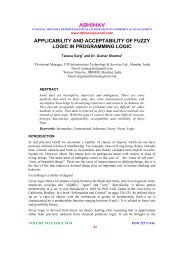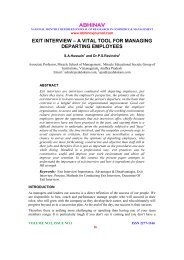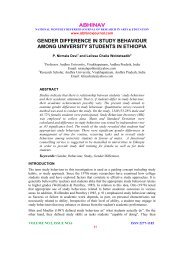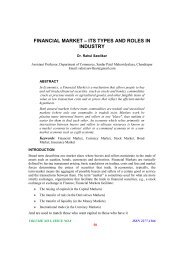Talent retention in Indian BPO sector: A challenge - Abhinav Institute ...
Talent retention in Indian BPO sector: A challenge - Abhinav Institute ...
Talent retention in Indian BPO sector: A challenge - Abhinav Institute ...
Create successful ePaper yourself
Turn your PDF publications into a flip-book with our unique Google optimized e-Paper software.
TALENT RETENTION IN INDIAN <strong>BPO</strong> SECTOR: A<br />
CHALLENGE<br />
Anil Kumar Hagargi<br />
Research Scholar, Dept. of Management studies & Research, Gulbarga University, Gulbarga<br />
Email: anil_za007@rediffmail.com<br />
ABSTRACT<br />
India is considered as hub for outsourc<strong>in</strong>g and we can f<strong>in</strong>d as many as<br />
<strong>BPO</strong>’s on the <strong>Indian</strong> soil as compared to any other nation. Today <strong>Indian</strong><br />
<strong>BPO</strong> and ITES are witness<strong>in</strong>g attrition at large-scale and <strong>retention</strong> has<br />
become a difficult task. We can also term it as a talent crunch <strong>in</strong> the<br />
<strong>in</strong>dustry. Industry is feel<strong>in</strong>g heat and <strong>challenge</strong> to reta<strong>in</strong> the talent <strong>in</strong> the<br />
organizations. The most critical and delicate situation is to withhold the best<br />
talent <strong>in</strong> the organization. Many reputed employers <strong>in</strong> the <strong>in</strong>dustry have<br />
undergone this crunch of talent <strong>retention</strong>. The <strong>sector</strong> is contribut<strong>in</strong>g a lot<br />
<strong>Indian</strong> economy and also creat<strong>in</strong>g employment opportunity especially to the<br />
youth and perception of youth towards the <strong>sector</strong> is found to be positive. The<br />
<strong>BPO</strong>/ITES <strong>sector</strong> is always placed on top whenever we take the word the<br />
attrition. This paper hence focuses on how talent could be reta<strong>in</strong>ed <strong>in</strong> the<br />
<strong>BPO</strong>/ITES <strong>sector</strong> where attrition is always a worry. It also throws light on<br />
what organizations need to do to reta<strong>in</strong> their quality workforce and ma<strong>in</strong>ta<strong>in</strong><br />
the path to obta<strong>in</strong> goals The major causes are <strong>in</strong>flexible shift tim<strong>in</strong>gs, health<br />
and stress issues, rotational off, hectic work pressure, etc It is very<br />
important for us to check <strong>in</strong> depth the major causes for attrition and then to<br />
know how talent can be reta<strong>in</strong>ed so that it makes easy to achieve the set<br />
goals of the organisation. The paper also focus on various reasons for<br />
<strong>in</strong>crease <strong>in</strong> attrition rate <strong>in</strong> the <strong>sector</strong> and how it can be curbed & steps<br />
taken by <strong>sector</strong> <strong>in</strong> reduc<strong>in</strong>g attritions and keep employees motivated. This<br />
also enables <strong>in</strong> <strong>in</strong>creas<strong>in</strong>g the profitability and also a driv<strong>in</strong>g force to<br />
achieve the goals of the organisation. There is no question about <strong>in</strong>fra but<br />
on the other hand the <strong>sector</strong> must aim <strong>in</strong> giv<strong>in</strong>g recognition and rewards at<br />
right time and at right place are very important to reta<strong>in</strong> employees. The<br />
<strong>sector</strong> should assess the reasons for attrition as we all know there are<br />
various reasons and how to solve them. The <strong>sector</strong> should look forward to<br />
learn from exit <strong>in</strong>terviews, grievances and compla<strong>in</strong>ts should be treated with<br />
utmost care and counsel<strong>in</strong>g should be used as tool to reta<strong>in</strong> the best talent.<br />
INTRODUCTION<br />
The last decade witnessed a remarkable growth and development of the <strong>Indian</strong> economy.<br />
This was due to the advent of the technological front and a radical change <strong>in</strong> the bus<strong>in</strong>ess<br />
VOLUME NO.1, ISSUE NO.6 ISSN 2277-1166<br />
71
ABHINAV<br />
NATIONAL MONTHLY REFEREED JOURNAL OF REASEARCH IN COMMERCE & MANAGEMENT<br />
www.abh<strong>in</strong>avjournal.com<br />
practices. <strong>BPO</strong>/ITES <strong>sector</strong> is fast grow<strong>in</strong>g and the companies choose to outsource their noncore<br />
processes so that they can concentrate on their core ones. In this scenario, the talent<br />
management has been one of the toughest tasks <strong>in</strong> <strong>BPO</strong>s. Due to exist<strong>in</strong>g and flexible job<br />
opportunities <strong>in</strong> the <strong>in</strong>dustry, talent raids, talent wars, talent shortage and talent <strong>retention</strong> and<br />
strategies have become part and parcel of <strong>BPO</strong>s. The rate of attrition has been a major<br />
concern which <strong>in</strong>sists the management of the organization to th<strong>in</strong>k on how to reta<strong>in</strong> the talent<br />
they hired. This is one part of human resources which needs prime focus and attention so that<br />
it may not h<strong>in</strong>der the smooth flow of process and also journey to get the goals <strong>in</strong>to the kitty.<br />
Thus we can exclaim that the advent of <strong>BPO</strong>s has been an eternal <strong>in</strong>ventory of opportunities.<br />
It can also be termed as the renaissance of <strong>Indian</strong> job market under global framework.<br />
The h<strong>in</strong>drances or <strong>challenge</strong>s faced by the <strong>BPO</strong> <strong>sector</strong> could be diversified <strong>in</strong>ternal and<br />
external h<strong>in</strong>drances. The <strong>in</strong>ternal <strong>challenge</strong>s <strong>in</strong>clude shortage of competent managers for the<br />
middle and senior management and the high attrition rates. The external <strong>challenge</strong> is <strong>in</strong> the<br />
form of opposition from the US politicians and the UK labor unions aga<strong>in</strong>st shift<strong>in</strong>g of the<br />
<strong>BPO</strong> operations by local companies to India. One of the most significant <strong>in</strong>ternal <strong>challenge</strong>s<br />
is high attrition rates.<br />
Attrition refers to a gradual, natural reduction <strong>in</strong> membership or personnel, as through<br />
retirement, resignation, or death. Attrition <strong>in</strong> the <strong>BPO</strong> <strong>in</strong>dustry is twofold. One part of the<br />
attrition is where the employee leaves the <strong>in</strong>dustry entirely. The other section of attrition is<br />
where the employee jo<strong>in</strong>s another firm <strong>in</strong> the <strong>in</strong>dustry. It not only <strong>in</strong>dicates the loss of talent<br />
<strong>in</strong> the company, but also <strong>in</strong>cludes the cost of hir<strong>in</strong>g and tra<strong>in</strong><strong>in</strong>g the new employees. This is<br />
witnessed almost at all levels <strong>in</strong> the organization. Accord<strong>in</strong>g to some analysts (<strong>BPO</strong> India<br />
2004), <strong>in</strong> general, the attrition rate fluctuates between 20% and 40%, while <strong>in</strong> the best<br />
companies, it averages around 15%. As per NASSCOM (2004) report, the outsourc<strong>in</strong>g<br />
<strong>in</strong>dustry would have a shortage of 262,000 professionals by 2012. Despite potential for<br />
tremendous growth, <strong>BPO</strong> <strong>in</strong>dustry cont<strong>in</strong>ues to suffer from high level of attrition stemm<strong>in</strong>g<br />
from factors like high levels of stress and lack of opportunities for growth. Attrition <strong>in</strong> <strong>BPO</strong>,<br />
though vary<strong>in</strong>g from <strong>in</strong>dustry to <strong>in</strong>dustry has reached an all-time high level of nearly 60%<br />
(<strong>BPO</strong> India 2004). The high attrition rate also affects the productivity of the organization.<br />
The organizations have to combat with high attrition rates and reta<strong>in</strong> the talent <strong>in</strong> the<br />
organization so that they may not only prosper <strong>in</strong> profitability, but also <strong>in</strong> <strong>in</strong>tangible assets<br />
such as goodwill and employee satisfaction which will fetch most fame <strong>in</strong> bus<strong>in</strong>ess. When<br />
<strong>in</strong>ternal issues are sorted out, on the other hand, the organizations will be scaled high<br />
automatically <strong>in</strong> the growth rate. Employee <strong>retention</strong> is vital to the long term health and<br />
success of any bus<strong>in</strong>ess organization, especially <strong>in</strong> case of <strong>BPO</strong>s where the organizations<br />
spend so much <strong>in</strong> the recruitment and their <strong>in</strong>itial and ongo<strong>in</strong>g tra<strong>in</strong><strong>in</strong>g of the employees.<br />
Organizational issues such as time and <strong>in</strong>vestment <strong>in</strong>volved <strong>in</strong> tra<strong>in</strong><strong>in</strong>g; knowledge lost due<br />
to attrition; mourn<strong>in</strong>g and <strong>in</strong>secure coworkers and a costly replacement of candidate costs a<br />
lot to the organization. The concept of employee <strong>retention</strong> should be very dist<strong>in</strong>ctly<br />
understood and realized by organizations. The <strong>retention</strong> strategies designed should be such<br />
that the retentive forces are maximized and the debilitat<strong>in</strong>g forces m<strong>in</strong>imized. Efforts should<br />
be thus made very effectively <strong>in</strong> the organization.<br />
Many <strong>BPO</strong>s are adopt<strong>in</strong>g some fundamental actions to reta<strong>in</strong> employees, <strong>in</strong>clud<strong>in</strong>g salary<br />
surveys to stay shoulder to shoulder of the market, culture-build<strong>in</strong>g exercises for employees,<br />
VOLUME NO.1, ISSUE NO.6 ISSN 2277-1166<br />
72
ABHINAV<br />
NATIONAL MONTHLY REFEREED JOURNAL OF REASEARCH IN COMMERCE & MANAGEMENT<br />
www.abh<strong>in</strong>avjournal.com<br />
exit <strong>in</strong>terviews, counsel<strong>in</strong>g, employee development programs, rewards and recognition, as<br />
well as <strong>in</strong>creased pay and benefits. Attrition is higher when an employee is 12 to 18 months<br />
old <strong>in</strong> the organization. Therefore, suitable growth opportunities, appraisals and suitable<br />
designations should be provided at right time to reta<strong>in</strong> the talent. Most of the organizations<br />
seem to follow the strategies very promptly but few are <strong>in</strong> va<strong>in</strong> yet to reta<strong>in</strong> the talent. Well<br />
educated and <strong>in</strong>tellectual manpower is not reta<strong>in</strong>ed due to issues of improper placement <strong>in</strong><br />
<strong>BPO</strong>s. Yet many people are conduct<strong>in</strong>g research and study on employee <strong>retention</strong>.<br />
Why employees quit an organization?<br />
In an <strong>in</strong>dustry like <strong>BPO</strong>, the work can often be monotonous and opportunities for career<br />
growth m<strong>in</strong>imal. So when opportunities beckon, the high rate of attrition is not surpris<strong>in</strong>g.<br />
However, there are some common reasons that especially cause people to leave. Surveys<br />
have listed the follow<strong>in</strong>g as few major reasons for attrition;<br />
Night shifts and rotational shifts<br />
For higher education<br />
Inability to handle various types of stress<br />
Monotonous work<br />
Company policies are not conducive<br />
Lack of career growth<br />
Problems with those <strong>in</strong> senior positions or peer managers<br />
For higher salary and better designation<br />
No time for personal life<br />
Misguidance by the company<br />
Grievances<br />
Dissatisfied by appraisal system<br />
Dissatisfied by <strong>in</strong>ternal job post<strong>in</strong>g (IJP), etc.<br />
Thus, these were few reasons which were highlighted by the employees when exit <strong>in</strong>terviews<br />
were conducted by the <strong>BPO</strong>s. Hence, we can analyze that its not only the money and career<br />
factors which propel the employees to quit jobs <strong>in</strong> <strong>BPO</strong>s, but it is also <strong>in</strong>fluenced by mental,<br />
physical and emotional factors. Due to huge output of students from colleges and due to the<br />
good communication skills and care, many fresher’s get attracted to the <strong>BPO</strong> <strong>sector</strong> as they<br />
want to explore the corporate world and make some money, they also get attracted to hikes<br />
and better offers from other companies and then they opt to change company as there would<br />
be a hike <strong>in</strong> the salary by next hir<strong>in</strong>g company. But these days, many <strong>BPO</strong>s have made<br />
efforts to curb attrition and have been traced out several safety measures to keep the<br />
employees <strong>in</strong> the organization. Employee <strong>retention</strong> is obviously one of the toughest tasks <strong>in</strong><br />
the organization. Strategies have been drafted so that it may stop attrition rate <strong>in</strong> <strong>BPO</strong>s which<br />
is very high.<br />
VOLUME NO.1, ISSUE NO.6 ISSN 2277-1166<br />
73
ABHINAV<br />
NATIONAL MONTHLY REFEREED JOURNAL OF REASEARCH IN COMMERCE & MANAGEMENT<br />
www.abh<strong>in</strong>avjournal.com<br />
If an employee resigns, then good amount of time is lost <strong>in</strong> hir<strong>in</strong>g a new employee and then<br />
tra<strong>in</strong><strong>in</strong>g him/her and this goes to the loss of the company directly which many a times goes<br />
unnoticed. And even after this you cannot assure us of the same efficiency from the new<br />
employee (He might be better and might not be). You require time to judge his capabilities<br />
and work nature. The loss is even graver if he/she is Your Knowledge Bank, this can br<strong>in</strong>g<br />
your process to a standstill even. And above all these th<strong>in</strong>gs, one resignation many a times<br />
triggers a cha<strong>in</strong> reaction among other employees, lead<strong>in</strong>g to a negative effect. The Hay<br />
Group completed their study <strong>in</strong> 2008 called “<strong>BPO</strong> Sector Special Survey”. The study<br />
focused on the compensation and benefits of almost 39,000 <strong>Indian</strong> jobs <strong>in</strong> 12 participat<strong>in</strong>g<br />
companies of <strong>BPO</strong> <strong>sector</strong>. This study revealed three important reasons for high rate of<br />
attrition <strong>in</strong> <strong>Indian</strong> <strong>BPO</strong>s; a robust job market, emphasis on retirement benefits and low<br />
variable pay.<br />
India has emerged as the top dest<strong>in</strong>ation for global offshore outsourc<strong>in</strong>g. Accord<strong>in</strong>g to the<br />
latest NASSCOM McK<strong>in</strong>sey Survey IT & ITES would add 7% to India's GDP by 2010<br />
along with the creation of 8.8 million new jobs, and the number of professionals employed <strong>in</strong><br />
IT & ITES <strong>sector</strong> is estimated at 1,045,000 as of March 2005. However, among the most<br />
complex problem faced by the IT & ITES <strong>in</strong>dustry is labor attrition. Accord<strong>in</strong>g to analysts,<br />
employee attrition rate <strong>in</strong> this <strong>sector</strong> varies between 20% and 40%, while it is around 15<br />
percent <strong>in</strong> top firms. If these are any <strong>in</strong>dications, the outsourc<strong>in</strong>g <strong>in</strong>dustry is likely to face a<br />
shortage of 262,000 professionals by 2010. There is virtually a war among the organizations<br />
for acquir<strong>in</strong>g talent, which is scarce. In this context the current paper explores what<br />
organizations are do<strong>in</strong>g to reta<strong>in</strong> employees. It also explores out the reasons why employees<br />
leave the organisation and tries to evolve strategies for <strong>retention</strong> of scarce IT talent <strong>in</strong> the<br />
fiercely competitive labor market.<br />
Look<strong>in</strong>g at the big picture of the much realized potential of the <strong>BPO</strong> <strong>in</strong>dustry <strong>in</strong> India and the<br />
impend<strong>in</strong>g curse of attrition <strong>in</strong> this <strong>sector</strong>, it can be confidently said that the problem cannot<br />
be overlooked. There is a dire need of tackl<strong>in</strong>g the problem of attrition <strong>in</strong> the <strong>BPO</strong> <strong>in</strong>dustry<br />
of India and for this employee motivation has been chosen as an effective tool. There is need<br />
to develop a concurrent strategic method, an <strong>in</strong>novative development paradigm that can be<br />
utilized to curb the ever-<strong>in</strong>creas<strong>in</strong>g attrition rate <strong>in</strong> the <strong>BPO</strong> <strong>in</strong>dustry. Thus the need for this<br />
study can be clearly def<strong>in</strong>ed <strong>in</strong> two po<strong>in</strong>ts:<br />
1. Attrition is a burn<strong>in</strong>g problem for the promis<strong>in</strong>g <strong>in</strong>dustry of <strong>BPO</strong>, especially because<br />
it fails to tap the full utilization of the human resources and wastes much of its time,<br />
money and resources due to this.<br />
2. Dearth of motivation among the <strong>BPO</strong> employees is one of the bitter truths that is<br />
responsible for the attrition <strong>in</strong> this <strong>sector</strong>, and it is time we enhanced it <strong>in</strong> the <strong>BPO</strong><br />
<strong>sector</strong>.<br />
Attrition <strong>in</strong> the <strong>BPO</strong> <strong>in</strong>dustry is twofold. One part of the attrition is where the employee<br />
leaves the <strong>in</strong>dustry entirely. The other section of attrition is where the employee jo<strong>in</strong>s<br />
another firm <strong>in</strong> the <strong>in</strong>dustry. Both the sections have separate reasons which need to be<br />
identified. The primary reason for people leav<strong>in</strong>g the <strong>in</strong>dustry is due to the cause that the<br />
<strong>in</strong>dustry is viewed as a gap filler occupation. There seems to be a flaw <strong>in</strong> the way the<br />
<strong>in</strong>dustry is structured. The <strong>in</strong>dustry has been ma<strong>in</strong>ly dependent on youth who take out time<br />
VOLUME NO.1, ISSUE NO.6 ISSN 2277-1166<br />
74
ABHINAV<br />
NATIONAL MONTHLY REFEREED JOURNAL OF REASEARCH IN COMMERCE & MANAGEMENT<br />
www.abh<strong>in</strong>avjournal.com<br />
to work, make money <strong>in</strong> the process while th<strong>in</strong>k<strong>in</strong>g of career alternatives. Hence for this<br />
group <strong>BPO</strong> is never a long term career but only as a part time job. The easy availability of<br />
<strong>BPO</strong> jobs is only a source of easy money till the time there is no other source of fund<strong>in</strong>g.<br />
Also the unfriendly work<strong>in</strong>g conditions, late night work shifts, high tension jobs acts as a<br />
deterrent for people to stick to this <strong>in</strong>dustry for long time. In addition, the <strong>BPO</strong> jobs are not<br />
be<strong>in</strong>g taken with a positive spirit by the society on a large .Research says that nearly 50% of<br />
the people quit the <strong>in</strong>dustry every year.<br />
<strong>Talent</strong> <strong>retention</strong>: a <strong>challenge</strong><br />
Fundamental changes are tak<strong>in</strong>g place <strong>in</strong> the work force and the workplace that promise to<br />
radically alter the way companies relate to their employees. Hir<strong>in</strong>g and reta<strong>in</strong><strong>in</strong>g good<br />
employees have become the chief concerns of nearly every company <strong>in</strong> every <strong>in</strong>dustry.<br />
Companies that understand what their employees want and need <strong>in</strong> the workplace and make<br />
a strategic decision to proactively fulfill those needs will become the dom<strong>in</strong>ant players <strong>in</strong><br />
their respective markets.<br />
Intelligent employers always realize the importance of reta<strong>in</strong><strong>in</strong>g the best talent. Reta<strong>in</strong><strong>in</strong>g<br />
talent has never been so important <strong>in</strong> the <strong>Indian</strong> scenario; however, th<strong>in</strong>gs have changed <strong>in</strong><br />
recent years. In prom<strong>in</strong>ent <strong>Indian</strong> metros at least, there is no dearth of opportunities for the<br />
best <strong>in</strong> the bus<strong>in</strong>ess, or even for the second or the third best. Retention of key employees and<br />
treat<strong>in</strong>g attrition troubles has never been so important to companies.<br />
In an <strong>in</strong>tensely competitive environment, where HR managers are poach<strong>in</strong>g from each other,<br />
organizations can either hold on to their employees tight or lose them to competition. For<br />
gone are the days, when employees would stick to an employer for years for want of a better<br />
choice. Now, opportunities abound.<br />
<strong>Talent</strong> <strong>retention</strong>, especially of the best, most desirable employees, is a key <strong>challenge</strong> <strong>in</strong><br />
organizations today. Thus, it is critical to the long term health and success of the<br />
organization. Managers readily agree that reta<strong>in</strong><strong>in</strong>g your best employees ensures customer<br />
satisfaction, product sales, satisfied coworkers and report<strong>in</strong>g staff, effective succession<br />
plann<strong>in</strong>g and deeply imbedded organizational knowledge and learn<strong>in</strong>g.<br />
<strong>Talent</strong> <strong>retention</strong> matters. Organizational issues such as tra<strong>in</strong><strong>in</strong>g time and <strong>in</strong>vestment; lost<br />
knowledge; mourn<strong>in</strong>g, <strong>in</strong>secure co-workers and a costly candidate search aside, fail<strong>in</strong>g to<br />
reta<strong>in</strong> a key employee is costly. Various estimates suggest that los<strong>in</strong>g a middle manager costs<br />
an organization up to 100 percent of his salary. The loss of a senior executive is even more<br />
costly.<br />
<strong>Talent</strong> <strong>retention</strong> is critically important for a second societal reason, too. Over the next few<br />
years while Baby Boomers (age 40 to 58) retire, the upcom<strong>in</strong>g Generation X population<br />
numbers 44 million people (ages 25-34), compared to 76 million Baby Boomers available<br />
for work. Simply stated: there are a lot fewer people available to work. <strong>Talent</strong> <strong>retention</strong> is<br />
one of the primary measures of the health of your organization. If an organization is los<strong>in</strong>g<br />
its critical staff members, it can safely bet that other people <strong>in</strong> its departments are look<strong>in</strong>g as<br />
well. Exit <strong>in</strong>terviews with depart<strong>in</strong>g employees provide valuable <strong>in</strong>formation you can use to<br />
reta<strong>in</strong> rema<strong>in</strong><strong>in</strong>g staff.<br />
VOLUME NO.1, ISSUE NO.6 ISSN 2277-1166<br />
75
ABHINAV<br />
NATIONAL MONTHLY REFEREED JOURNAL OF REASEARCH IN COMMERCE & MANAGEMENT<br />
www.abh<strong>in</strong>avjournal.com<br />
The bottom l<strong>in</strong>e of talent <strong>retention</strong> is the quality of the supervision an employee receives is<br />
critical to employee <strong>retention</strong>. People leave managers and supervisors more often than they<br />
leave companies or jobs. It is not enough that the manager is well-liked or a nice person.<br />
Sure, a nice, likeable manager earns some po<strong>in</strong>ts to the organization with its employees. A<br />
draconian, nasty, or controll<strong>in</strong>g manager takes po<strong>in</strong>ts away from organization. So will below<br />
market benefits and compensation. But, a manager or supervisor, who is a pro at employee<br />
<strong>retention</strong>, knows that the quality of the supervision is the key factor <strong>in</strong> talent <strong>retention</strong>.<br />
Companies vy<strong>in</strong>g among themselves to unearth talent and employ<strong>in</strong>g them, is not a new<br />
phenomenon. Employers know that attract<strong>in</strong>g outstand<strong>in</strong>g talent is basic to the success of<br />
their companies. But what is necessary is that the company’s search for talent must be<br />
comprehensive, and a systematic approach for recruitment and <strong>retention</strong> of candidates be<br />
followed. This book endeavors to provide the readers an <strong>in</strong>sight <strong>in</strong>to how companies could<br />
compete for talent by adopt<strong>in</strong>g necessary changes <strong>in</strong> management, organization design, and<br />
human resource policies <strong>in</strong> a way that can turn the company <strong>in</strong>to a magnet for top<br />
performers.<br />
Employees are <strong>in</strong>ternal customers to the organization and the ability of the organization <strong>in</strong><br />
fulfill<strong>in</strong>g their needs reflects its philosophy and core values. Compet<strong>in</strong>g <strong>in</strong> the labor market<br />
requires a proper understand<strong>in</strong>g of employees’ needs and evolv<strong>in</strong>g right strategies of hir<strong>in</strong>g<br />
and reta<strong>in</strong><strong>in</strong>g them so that the companies are able to collect a band of good workers who can<br />
contribute their best to the organization. The statement by Narayana Murthy, Chairman,<br />
Infosys, “My Company’s assets walk out of the door every even<strong>in</strong>g” truly captures the<br />
dynamics of the new economy. With such a great emphasis on human capital, it is critical for<br />
every organization to resort to means that offer quality recruitment solutions at competitive<br />
costs.<br />
At this po<strong>in</strong>t, it is important to note what Jack Welch, former CEO of GE, said <strong>in</strong> an<br />
<strong>in</strong>terview when asked about the secret of his success: “My ma<strong>in</strong> job was develop<strong>in</strong>g talent; I<br />
was a gardener, provid<strong>in</strong>g water and other nourishment to our top 750 people.” Jack said <strong>in</strong><br />
the same breath: “Of course, I had to pull out some weeds too”. This statement by Jack<br />
Welch br<strong>in</strong>gs out the significance of talent management. Though, it is impossible to scrap<br />
problems totally, there are certa<strong>in</strong> ways by which <strong>BPO</strong> managements can tackle attrition.<br />
S<strong>in</strong>ce the <strong>BPO</strong> environment is unique, these companies need to develop <strong>in</strong>novative ways to<br />
tackle them. Human Resources department of a <strong>BPO</strong> must address these issues, and along<br />
with the management need to evolve strategies to reta<strong>in</strong> employees at all levels.<br />
Significance of talent <strong>retention</strong><br />
Now that so much is be<strong>in</strong>g done by organizations to reta<strong>in</strong> its employees, why is <strong>retention</strong> so<br />
important? Is it just to reduce the turnover costs? Well, the answer is a def<strong>in</strong>ite no. It’s not<br />
only the cost <strong>in</strong>curred by a company that emphasizes the need of reta<strong>in</strong><strong>in</strong>g employees but<br />
also the need to reta<strong>in</strong> talented employees from gett<strong>in</strong>g poached.<br />
The process of talent <strong>retention</strong> will benefit an organization <strong>in</strong> the follow<strong>in</strong>g ways:<br />
The Cost of Turnover: The cost of employee turnover adds hundreds of thousands of<br />
money to a company's expenses. While it is difficult to fully calculate the cost of turnover<br />
VOLUME NO.1, ISSUE NO.6 ISSN 2277-1166<br />
76
ABHINAV<br />
NATIONAL MONTHLY REFEREED JOURNAL OF REASEARCH IN COMMERCE & MANAGEMENT<br />
www.abh<strong>in</strong>avjournal.com<br />
(<strong>in</strong>clud<strong>in</strong>g hir<strong>in</strong>g costs, tra<strong>in</strong><strong>in</strong>g costs and productivity loss), <strong>in</strong>dustry experts often quote<br />
25% of the average employee salary as a conservative estimate.<br />
Loss of Company Knowledge: When an employee leaves, he takes with him valuable<br />
knowledge and <strong>in</strong>formation about the company, customers, current projects and past history<br />
(sometimes to competitors). Often much time and money has been spent on the employee <strong>in</strong><br />
expectation of a future return. When the employee leaves, the <strong>in</strong>vestment is not realized.<br />
Interruption of Customer Service: Customers and clients do bus<strong>in</strong>ess with a company <strong>in</strong><br />
part because of the people. Relationships are developed that encourage cont<strong>in</strong>ued<br />
sponsorship of the bus<strong>in</strong>ess. When an employee leaves, the relationships that employee built<br />
for the company are severed, which could lead to potential customer loss.<br />
Turnover leads to more turnovers: When an employee term<strong>in</strong>ates, the effect is felt<br />
throughout the organization. Co-workers are often required to pick up the slack. The<br />
unspoken negativity often <strong>in</strong>tensifies for the rema<strong>in</strong><strong>in</strong>g staff. Whenever an employee quits<br />
the organization it is felt throughout the organizational set up as the team members may be<br />
curious to know why that particular employee left the organization and may <strong>in</strong>fluence<br />
another employee to th<strong>in</strong>k on quitt<strong>in</strong>g the job if this is go<strong>in</strong>g to happen certa<strong>in</strong>ly attrition rate<br />
of the organization is go<strong>in</strong>g to be up.<br />
Goodwill of the company: The goodwill of a company is ma<strong>in</strong>ta<strong>in</strong>ed when the attrition<br />
rates are low. Higher <strong>retention</strong> rates motivate potential employees to jo<strong>in</strong> the organization.<br />
Rega<strong>in</strong><strong>in</strong>g efficiency: If an employee resigns, then good amount of time is lost <strong>in</strong> hir<strong>in</strong>g a<br />
new employee and then tra<strong>in</strong><strong>in</strong>g him/her and this goes to the loss of the company directly<br />
which many a times goes unnoticed. And even after this you cannot assure us of the same<br />
efficiency from the new employee.<br />
Manag<strong>in</strong>g <strong>retention</strong><br />
The task of manag<strong>in</strong>g the employees’ <strong>retention</strong> could be understood <strong>in</strong> three stage process:<br />
1. Identify the cost of employee turnover.<br />
2. Understand why employee leaves.<br />
3. Implement <strong>retention</strong> strategies.<br />
Now let’s discuss these three stages <strong>in</strong> detail;<br />
1. Identify the cost of employee turnover:<br />
The organizations should start with identify<strong>in</strong>g the employee turnover rates with<strong>in</strong> a<br />
particular time period and benchmark it with the competitor organizations. This will help <strong>in</strong><br />
assess<strong>in</strong>g the whether the talent <strong>retention</strong> rates are healthy <strong>in</strong> the company. Secondly, the<br />
cost of employee turnover can be calculated. Accord<strong>in</strong>g to a survey, on an average, attrition<br />
costs companies 18 months’ salary for each manager or professional who leaves, and 6<br />
months’ pay for each hourly employee who leaves. This amounts to major organizational<br />
and f<strong>in</strong>ancial stress, consider<strong>in</strong>g that one out of every three employees plans to leave his or<br />
her job <strong>in</strong> the next two years.<br />
VOLUME NO.1, ISSUE NO.6 ISSN 2277-1166<br />
77
ABHINAV<br />
NATIONAL MONTHLY REFEREED JOURNAL OF REASEARCH IN COMMERCE & MANAGEMENT<br />
www.abh<strong>in</strong>avjournal.com<br />
2. Understand why employee leaves:<br />
Why employees leave often puzzles top management. Exit <strong>in</strong>terviews are an ideal way of<br />
record<strong>in</strong>g and analyz<strong>in</strong>g the factors that have led employees to leave the organization. They<br />
allow an organization to understand the reasons for leav<strong>in</strong>g and underly<strong>in</strong>g issues. However<br />
employees never provide appropriate response to the asked questions. So an impartial person<br />
should be appo<strong>in</strong>ted with whom the employees feel comfortable <strong>in</strong> express<strong>in</strong>g their<br />
op<strong>in</strong>ions.<br />
3. Implement <strong>retention</strong> strategies:<br />
Once the causes of attrition are found, a strategy is to be implemented so as to reduce<br />
employee turnover. The most effective strategy is to adopt a holistic approach to deal<strong>in</strong>g<br />
with attrition.<br />
An effective <strong>retention</strong> strategy will seek to ensure:<br />
Attraction and recruitment strategies enable selection of the ‘right’ candidate for<br />
each role/organization.<br />
New employees’ <strong>in</strong>itial experiences of the organization are positive.<br />
Appropriate development opportunities are available to employees, and that they are<br />
kept aware of their likely career path with the organization.<br />
The organization’s reward strategy reflects the employee drivers.<br />
The leav<strong>in</strong>g process is managed effectively.<br />
CONCLUSION<br />
Today <strong>retention</strong> has become key tool for success but <strong>retention</strong> has become a tough job for<br />
the <strong>sector</strong> as attrition is on the rise due to various reasons employer should concern the<br />
people and provide flexible shift and week end off so that employees feel comfortable the<br />
next day as they will be spend<strong>in</strong>g some time family. Retention has become a key <strong>challenge</strong><br />
for the <strong>BPO</strong> <strong>in</strong>dustry and how it has to be managed <strong>in</strong> keep<strong>in</strong>g a static workforce <strong>in</strong> the<br />
organization for a longer version of the game. With <strong>retention</strong> on the card the company can<br />
save <strong>in</strong>vestment on recruitment and can turn it as cost effectiveness. As the <strong>sector</strong> is open<br />
and people has various choice to work for that attrition is on the rise to m<strong>in</strong>imize it and<br />
manage the <strong>sector</strong> should plan the career path of people and provide them rewards and<br />
promotion on time and keep them satisfied and employees should not th<strong>in</strong>k of alternative<br />
employer.<br />
REFERENCES<br />
1. Human Resource & Personnel Management, 4 th Edition: K. Ashwatappa.<br />
2. A Framework of Human Resource Management: Gary Dessler.<br />
3. <strong>BPO</strong> India report 2004<br />
4. Nass.com report 2004<br />
5. www.bpowatch.com<br />
VOLUME NO.1, ISSUE NO.6 ISSN 2277-1166<br />
78
ABHINAV<br />
NATIONAL MONTHLY REFEREED JOURNAL OF REASEARCH IN COMMERCE & MANAGEMENT<br />
www.abh<strong>in</strong>avjournal.com<br />
6. www.bpo<strong>in</strong>dia.org<br />
7. www.nasscom.com.<br />
8. www.oppapers.com<br />
9. www.articlebase.com<br />
VOLUME NO.1, ISSUE NO.6 ISSN 2277-1166<br />
79

















